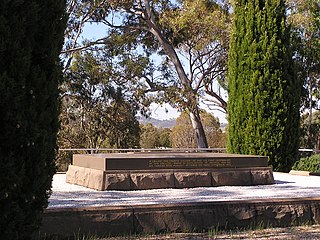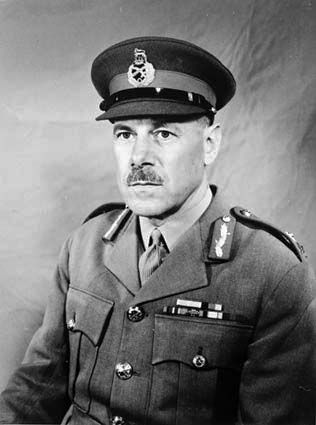Related Research Articles

Major General Sir William Throsby Bridges, was a senior Australian Army officer who was instrumental in establishing the Royal Military College, Duntroon and who served as the first Australian Chief of the General Staff. During the First World War he commanded the 1st Australian Division at Gallipoli, where he died of wounds on 18 May 1915, becoming the first Australian general officer to be killed during the war. He was the first Australian officer—and the first graduate of Kingston—to reach the rank of major general, the first to command a division, and the first to receive a knighthood. He is one of only two Australians killed in action in the Great War to be interred in Australia.

The Royal Military College, Duntroon, also known simply as Duntroon, is the Australian Army's officer training establishment. It was founded at Duntroon, in Canberra, Australian Capital Territory, in 1911 and is at the foot of Mount Pleasant near Lake Burley Griffin, close to the Department of Defence headquarters at Russell Hill. It is comparable to the United Kingdom's Royal Military Academy Sandhurst and the United States Military Academy at West Point. Duntroon is adjacent to the Australian Defence Force Academy (ADFA), which is Australian Defence Force's tri-service military academy that provides military and tertiary academic education for junior officers of the Australian Army, Royal Australian Air Force and the Royal Australian Navy.
Major General Alan Bishop Stretton, was a senior Australian Army officer. He came to public prominence through his work in charge of cleanup efforts at Darwin in the aftermath of Cyclone Tracy on Christmas Day 1974. As head of the National Disasters Organisation he managed the evacuation of 35,000 people in six days, including loading a jumbo jet with 673 passengers, mostly children, then a record for the most people aloft in the one aircraft.

Lieutenant General Sir Donald Beaumont Dunstan was an Australian Army officer who was Governor of South Australia from 23 April 1982 until 5 February 1991. A career officer, after joining the Army in 1940 during the Second World War, Dunstan graduated from the Royal Military College, Duntroon in 1942 and served as an infantry officer, seeing combat against the Japanese during the Bougainville Campaign in 1945. After the war, he served in a variety of appointments, including as commander of the 1st Australian Task Force during the Vietnam War. From 1977 to 1982 he held the appointment of Chief of the General Staff, before retiring from the Army having overseen a large-scale re-organisation. Afterwards, he became the longest-serving governor of South Australia. He died in 2011, at the age of 88.
Rear Admiral Peter Ross Sinclair, is a retired senior officer of the Royal Australian Navy who served as the 35th Governor of New South Wales from 8 August 1990 to 1 March 1996. Born in Manly, New South Wales, he was educated North Sydney Boys High School before joining the navy through the Royal Australian Naval College.

Thomas Rowe was a British-born architect, builder and goldminer who became one of Australia's leading architects of the Victorian era. He was also a politician, who was the first Mayor of Manly.

Sir Keith Stephen Jones, MB BS (Hons) FRCS (Edinburgh) FRACS FRAGP (Hon) FACEM (Hon) was an Australian general practitioner, surgeon and medical executive, who served as the 6th President of the Australian Medical Association, from 1973–1976, during the introduction of universal health care in Australia.

Air Marshal Sir Valston Eldridge Hancock, was a senior commander in the Royal Australian Air Force (RAAF). He served as Chief of the Air Staff from 1961 to 1965. A graduate of the Royal Military College, Duntroon, Hancock transferred from the Army to the RAAF in 1929 and qualified as a pilot. His administrative training at Duntroon saw him mainly occupy staff posts, including Deputy Director of Operations and Intelligence at RAAF Headquarters from 1931 to 1935, and Director of Works and Buildings from 1937 to 1939. During the early years of World War II, he commanded No. 1 Bombing and Gunnery School, and held senior planning and administrative positions. He eventually saw combat in the Aitape–Wewak campaign of the Pacific War during 1945. Flying Bristol Beaufort light bombers, he led first No. 100 Squadron, and later No. 71 Wing. His actions earned him the Distinguished Flying Cross.

Lieutenant General Sir Reginald George Pollard, was a senior commander in the Australian Army. He served as Chief of the General Staff from 1960 to 1963.

General Sir John Gordon Noel Wilton, was a senior commander in the Australian Army. He served as Chief of the General Staff (CGS), the Army's professional head, from 1963 until 1966, and as Chairman of the Chiefs of Staff Committee (CCOSC), forerunner of the role of Australia's Chief of the Defence Force, from 1966 until 1970. His eight-year tenure as senior officer of first the Army and then the Australian military spanned almost the entire period of the nation's involvement in the Vietnam War.

Air Marshal Sir Alister Murray Murdoch, was a senior commander in the Royal Australian Air Force (RAAF). He served as Chief of the Air Staff (CAS) from 1965 to 1969. Joining the Air Force in 1930, Murdoch trained as a seaplane pilot and participated in an Antarctic rescue mission for lost explorers in 1935. During World War II, he commanded No. 221 Squadron RAF in Europe and the Middle East, and later occupied senior positions on the staff of RAAF formations in the South West Pacific. His post-war appointments included Commandant of RAAF College from 1952 to 1953, Air Officer Commanding (AOC) Training Command from 1953 to 1955, Deputy Chief of the Air Staff from 1958 to 1959, and AOC Operational Command from 1962 to 1965.
The Officer Training Unit, Scheyville was a military training establishment for officers of the Australian Army. Located in the area of Scheyville in the Hawkesbury region of Sydney, Australia, the establishment was opened in April 1965 to train officer cadets who had been called up for service under the national service scheme and offered a short but rigorous commissioning course for trainees, tailored to meet the Army's need to increase the number of junior officers being produced in order to meet commitments to train national servicemen, and to provide platoon commanders for units serving overseas in Vietnam and other parts of Southeast Asia. It was closed in 1974 after the national service scheme was abolished in December 1972 and the last OCS Portsea class finished their time at Scheyville.

General Sir Arthur Leslie MacDonald, was a senior officer in the Australian Army, who served in the positions of Chief of the General Staff from 1975 to 1977, then Chief of the Defence Force Staff from 1977 to 1979; the professional head of the Australian Army and Australian Defence Force respectively.
Major General Alan Lindsay "Alby" Morrison, AO, DSO, MBE was a senior officer in the Australian Army. A graduate of the Royal Military College, Duntroon, Morrison was commissioned as an infantry officer in 1947 and served on occupation duties in Japan as part of the British Commonwealth Occupation Force. He later served with the 3rd Battalion, Royal Australian Regiment, seeing combat as a platoon commander during the Korean War. After serving on the headquarters of the 28th Commonwealth Brigade, he led the 9th Battalion, Royal Australian Regiment, during its combat tour during the Vietnam War. His later appointments included commander of the 1st Brigade and commandant of Duntroon. He retired from the Army in 1981 after 36 years of service, and died in 2008 at the age of 80.

Lieutenant General Sir Mervyn Francis Brogan, was a senior officer in the Australian Army who served as Chief of the General Staff from 1971 to 1973.

Major General Ronald Laurence Hughes, was a senior infantry officer in the Australian Army, seeing service during the Second World War, the Korean War and the Vietnam War. Joining the Australian Army in 1937, after graduating from the Royal Military College, Duntroon in 1939 he served in New Guinea and Borneo during the Second World War. He commanded the 3rd Battalion, Royal Australian Regiment during the static phase of the war in Korea in 1952–1953. Later, he commanded the 1st Australian Task Force in South Vietnam in 1967–68, during some of the heaviest fighting of the war experienced by the Australians. He subsequently filled a number of senior command and staff positions before retiring in 1977.

Major General Douglas (Tim) Vincent, was a senior officer in the Australian Army, seeing active service during the Second World War and the Vietnam War. Graduating from the Royal Military College, Duntroon in 1938 into the Signals Corps, he volunteered for service in the Second Australian Imperial Force soon after the outbreak of the Second World War and served in Syria, Western Europe and Borneo. Later, he served as Commander Australian Force Vietnam (COMAFV) during the Vietnam War. After a number of senior staff positions he retired in 1973. He was actively involved in defence issues in his retirement and served as a chairperson of the Returned and Services League of Australia (RSL) prior to his death.
Herbert Hilary Ingram "Hugh" Pearson MBE was an Australian surgeon and urologist. He was instrumental in the foundation of the Australian Kidney Foundation and was an early proponent of kidney transplants in Sydney. He was a Fellow of the Royal College of Surgeons, Edinburgh, and of the Royal Australasian College of Surgeons. Pearson served as President of the Urological Society of Australasia 1962–63.
Major General John Curtis Hartley, is an Australian defence and intelligence strategist and a retired officer of the Australian Army. He joined the army via the Royal Military College, Duntroon in 1962, was commissioned into the Royal Australian Infantry Corps and spent much of his career in military intelligence. He twice deployed on operations during the Vietnam War, during which he was Mentioned in Despatches on two occasions and seriously wounded, and commanded the Albury–Wodonga Military Area and the Army Apprentices' School (1984–87). He served as General Officer Commanding Training Command (1991–92), Director of the Defence Intelligence Organisation (1992–95), Deputy Chief of Army (1995–98), and Land Commander Australia (1998–00). Since his retirement from the army in 2000, Hartley has been involved in community and veterans' organisations and is an active contributor to discussion on defence and strategic issues.
References
- Barnes, I.L. (1974). Australian Gallant and Distinguished Service, Vietnam 1962–1973: Being a Record of British and Foreign Decorations Awarded to Australian Servicemen. Canberra, Australia: Military Historical Society of Australia. ISBN 0909859108.